

Genomes document ancient mass migration to Europe. 2 March 2015Last updated at 12:29 ET Nomadic herders moved en masse into Europe from the steppe around 4,500 years ago DNA analysis has revealed evidence for a massive migration into the heartland of Europe 4,500 years ago.

Farming was so Nice, It was Invented at Least Twice. The invention of farming some 10,000 years ago set the stage for the rise of civilizations in the Near East.
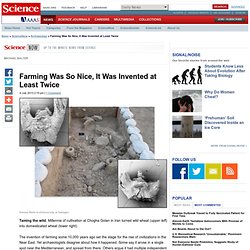
Yet archaeologists disagree about how it happened. Some say it arose in a single spot near the Mediterranean, and spread from there. Others argue it had multiple independent origins, a view that is getting new credence, thanks to findings from an early farming site in Iran. Whether farming arose once or a hundred times, it happened first in the Fertile Crescent, a broad region stretching from the Mediterranean Sea to Iran. Prehistoric Horse Genome Decoded, Pushing Back Origins Of Equine Lineage By 2 Million Years. First horses arose 4 million years ago. Claudia Feh, Association pour le cheval de Przewalski.

London’s roaming temple – new parts of the Mithraeum found.
Ciudad Blanca, Legendary Lost City, Possibly Found In Honduran Rain Forest. Stunning Byzantine Mosaic Uncovered in Israel. Archaeologists have uncovered an "extraordinary" mosaic that would've been used as the floor of a public building during the Byzantine Period in what is today Israel, the Israel Antiquities Authority (IAA) announced.

The colorful mosaic and public building, whose ceiling was covered in roof tiles, were uncovered in Kibbutz Bet Qama, in the B'nei Shimon regional council, prior to the construction of a road between Ma'ahaz and Devira Junction. "The minute we started excavating we found the mosaic, before we found the edges of the building," Davida Eisenberg Degen, an archaeologist with the IAA, told LiveScience during an interview. [ See Images of the Byzantine Mosaic ] The mosaic would've extended the area of the main building, with a total area about 40 feet long by 28 feet wide (12 meters by 8.5 meters).
Stars Aligned at Ancient Tomb in Spain. Some astronomical sleuthing has revealed the cultic past life of a Roman tomb in Spain.
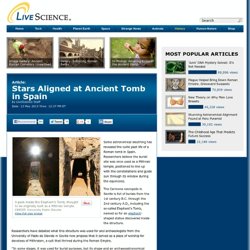
Researchers believe the burial site was once used as a Mithraic temple, positioned to line up with the constellations and guide sun through its window during the equinoxes. The Carmona necropolis in Seville is full of burials from the 1st century B.C. through the 2nd century A.D., including the so-called Elephant's Tomb, named so for an elephant -shaped statue discovered inside the structure. Researchers have debated what this structure was used for and archaeologists from the University of Pablo de Olavide in Seville now propose that it served as a place of worship for devotees of Mithraism, a cult that thrived during the Roman Empire. "In some stages, it was used for burial purposes, but its shape and an archaeoastronomical analysis suggest that it was originally designed and built to contain a Mithraeum [temple to Mithras]," study researcher Inmaculada Carrasco told the Spanish news agency SINC. Minoans Were European, Genetic Study Reveals.
The Minoans, the builders of Europe's first advanced civilization, really were European, new research suggests.
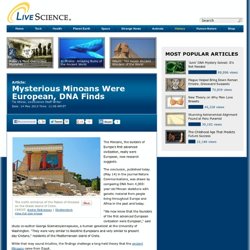
The conclusion, published today (May 14) in the journal Nature Communications, was drawn by comparing DNA from 4,000-year-old Minoan skeletons with genetic material from people living throughout Europe and Africa in the past and today. "We now know that the founders of the first advanced European civilization were European," said study co-author George Stamatoyannopoulos, a human geneticist at the University of Washington. "They were very similar to Neolithic Europeans and very similar to present day-Cretans," residents of the Mediterranean island of Crete.
Why Did Ancient Civilizations Build Such Huge Monuments? The “Dialogue of Civilizations” conference in Guatemala brought together archaeologists studying five ancient cultures to discuss their similarities and differences and what they can tell us about human society as a whole.
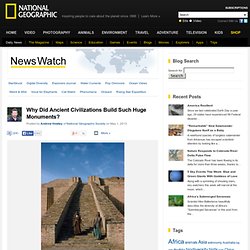
You can still be a part of the conversation, commenting on this post or tweeting using #5Civilizations. On the final day of the conference, after two days of individual presentations on ancient China, the Indus Valley, Mesopotamia, Egypt, and the Maya, all the presenters and hosts sat together on stage to discuss the nature of civilization and what we can apply today from the lessons of yesterday, or as the tagline for the Dialogue put it, how to view “the past as a window to the future.” Two days later, sitting on top of Temple IV in Tikal, looking out over the city’s ruins and miles and miles of jungle canopy, the group engaged in another conversation, centered around the collapse of civilizations.
Part 1: What Is “Civilization”? Why Such Big Buildings? Popular Archaeology. Archaeologists are rediscovering a Late Bronze Age Egyptian stronghold in the land of ancient Canaan.
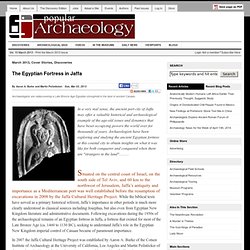
In a very real sense, the ancient port city of Jaffa may offer a valuable historical and archaeological example of the age-old issues and dynamics that have beset occupying powers the world over for thousands of years. Archaeologists have been exploring and studying the ancient Egyptian fortress at this coastal city to obtain insights on what it was like for both conqueror and conquered when there are "strangers in the land".......... Situated on the central coast of Israel, on the south side of Tel Aviv, and 60 km to the northwest of Jerusalem, Jaffa’s antiquity and importance as a Mediterranean port was well established before the resumption of excavations in 2008 by the Jaffa Cultural Heritage Project. In 2007 the Jaffa Cultural Heritage Project was established by Aaron A. Egypt’s Early Empire.
Uruk rises again in digital 3D. Article created on Friday, May 10, 2013 Uruk, in modern-day Iraq, is one of the first cities in the world and was populated almost without interruption for over 5,000 years – from the 4th millennium BC to the 1st millennium AD.
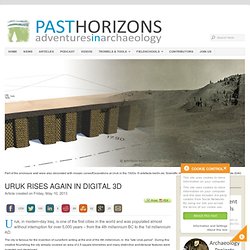
The city is famous for the invention of cuneiform writing at the end of the 4th millennium, in the “late Uruk period”. During this creative flourishing the city already covered an area of 2.5 square kilometres and many distinctive architectural features were invented and developed. View of the reconstructed “Stone-Cone building” with surrounding walls. © artefacts-berlin.de; Scientific material: German Archaeological Institute (DAI) The Elephant's Tomb in Carmona may have been a temple to the god Mithras. Public release date: 10-May-2013 [ Print | E-mail Share ] [ Close Window ] Contact: SINCinfo@agenciasinc.es 34-914-251-820FECYT - Spanish Foundation for Science and Technology.
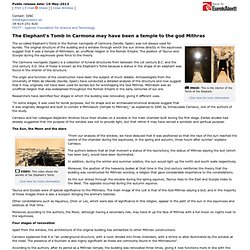
Queen's Skeleton? Gold-Bedecked Bones Found Near London Suggest Regal Status. Stonehenge Built For Feasts, Ancient Bones & Artifacts Suggest. By: Tia Ghose, LiveScience Staff Writer Published: 04/24/2013 01:50 PM EDT on LiveScience A site near Stonehenge has revealed archaeological evidence that hunters lived just a mile from Stonehenge roughly 5,000 years prior to the construction of the first stones, new research suggests. Wadi El Jarf Site Reveals Oldest Harbor, Papyri Ever Found In Egypt (PHOTOS) A group of archeologists believes it has discovered the oldest harbor ever found in Egypt, as well as the oldest papyri ever unearthed in the country. Egypt's State Information Service announced that a joint French-Egyptian mission has discovered the 4500-year-old remains of an ancient Egyptian harbor at the site of Wadi el-Jarf, on the Red Sea coast.
The ancient wharf and surrounding structures are located 112 miles south of Suez and have been dated to the reign of the pharoah Khufu. Also known as Cheops, Khufu reigned from 2575 to 2465 BCE and is renowned for constructing the Great Pyramid of Giza. Gaul Burial Site: French Archaeologists Unearth Warrior Remains At 2,300-Year-Old Cemetery. “The Myth of Persecution”: Early Christians weren’t persecuted. In the immediate aftermath of the Columbine High School massacre, a modern myth was born. A story went around that one of the two killers asked one of the victims, Cassie Bernall, if she believed in God.
Bernall reportedly said “Yes” just before he shot her. Bernall’s mother wrote a memoir, titled “She Said Yes: The Unlikely Martyrdom of Cassie Bernall,” a tribute to her daughter’s courageous Christian faith. Black Sea Fortress Yields Buried Treasure Said To Be 2,000 Years Old. Gaza's archaeological treasures at risk from war and neglect. 6 January 2013Last updated at 20:21 ET Continue reading the main story St Hilarion monastery Ruins of St Hilarion monastery (circa 4th C AD) found when construction workers began digging to build a new road. Excavations at Tel Rafah Excavations at Tel Rafah, an ancient settlement in southern Gaza, have revealed treasures including coins, pots and glass dating back to the Canaanite era.
Mammal's skull, Tel Rafah This skull of a large mammal was unearthed by archaeologists in Tel Rafah. Mosaic at St Hilarion The mosaic found at St Hilarion monastery is covered in sand when it is not being worked on to protect it from damage. Gateway to Old Gaza City. Staffordshire Hoard: 'Opening a window into the Mercian kingdom'
4 January 2013Last updated at 12:28 ET By Matt Lee BBC News Online The 81 new pieces of the Staffordshire Hoard will be valued by the Treasure Valuation Committee at the British Museum in March Speculation has already begun about how much 81 newly-discovered pieces of the Staffordshire Hoard will be worth. The pieces of Anglo-Saxon gold and silver were declared treasure by coroner Andrew Haigh on Friday and will now be valued by the British Museum. Terrace farming unearthed at ancient desert city of Petra. Digging into 2012's archaeology. What Perfumes Did Ancient Egyptians Use? Researchers Aim To Recreate 3,500-year-old Scent. The Ancient Egyptians cherished their fragrant scents, too, as perfume flacons from this period indicate.
In its permanent exhibition, Bonn University's Egyptian Museum has a particularly well preserved example on display. Pharaoh's throat was cut during royal coup, study shows. Reconstructing the site of Richard III’s last 'resting place' before Bosworth. If Richard III has indeed been discovered, finding will reshape our views of the past, historian say.
Augustus. Augustus (Latin: Imperator Caesar Divi F. Augustus,[note 1] 23 September 63 BC – 19 August 14 AD) was the founder of the Roman Empire and its first Emperor, ruling from 27 BC until his death in 14 AD. [note 2] Origin Of Life: New Study Spotlights Not Chemistry But How Living Things Store, Process Information. By: Tia Ghose, LiveScience Staff Writer Published: 12/11/2012 07:08 PM EST on LiveScience. Fit for a King: Largest Egyptian Sarcophagus Identified. Muslim Jokes Written 1,000 Years Ago Are Revealed In Ancient 'Guide To Gatecrashing' A Point of View: Pompeii's not-so-ancient Roman remains. Necrolestes Patagonensis: Molelike 'Grave Robber' Survived Dinosaur Extinction, Scientists Say. Legio IX Hispana. The Roman Ninth Legion's mysterious loss. Chinese villagers 'descended from Roman soldiers' Otzi The Iceman's Genes Reveal Central European Birth, But Sardinian Relatives.
Karkemish, Ancient City On Syria-Turkey Border, Excavated Amid Civil War. Complex Tool Discovery Argues for Early Human Smarts. Stash of Ancient Jewelry, Full-Figured Statues Discovered. Skulls shed new light on the evolution of the cat. Amarna letters. January 10th: Julius Caesar Makes His Historic, Illegal Crossing of the Rubicon at the Head of a Legion of Soldiers, Starting a Civil War Within Rome. Julius Caesar was Once Kidnapped by Pirates Who Demanded a Ransom of 20 Talents of Silver, Caesar Insisted They Ask for 50.
Grey Friars female skeleton is possibly of founder. Did bacteria spark evolution of multicellular life? Raw Food Not Enough to Feed Big Brains. Earliest Teeth: Prehistoric Armored Fish, Compagopiscis croucheri, May Be Oldest Toothy Animal. Dinosaur Cells In T. Rex Fossil? Shocking Find Gets New Support From Molecular Analysis. Bowhead whales: Ancient DNA sheds light on Arctic whale mysteries.
A sharper look into the past for archaeology and climate research. Ancient Egypt City Aligned With Sun on King's Birthday.